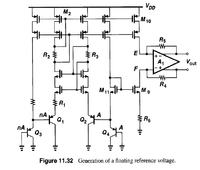Hamid.Kiumarsi
Full Member level 2
The schematic of this floating reference is at the end of chapter 11 of Razavi's CMOS book. (please refer to the attached file)
I am having a hard time to understand why Vgs9 = Vgs11. Based on this fact we Razavi has deduced that the voltage drop on R6 equals VBE4.
If Vgs9=Vgs11, then according to the fact that he assumes that M9 and M11 are identical, we should have ID9 = ID11
and since all emitter currents of Q1-Q4 are equal, then we would have ID9 = ID11 =====>>VBE4/R6 = (2Vt*ln )/R1
)/R1
The problem is: then Vout = (R4/R6)*VBE4 + 2(R5/R1)*Vt*ln ====>> Vout = (R4+R5) * (2Vt*ln
====>> Vout = (R4+R5) * (2Vt*ln )/R1 or Vout = (R4+R5) * VBE4/R6
)/R1 or Vout = (R4+R5) * VBE4/R6
Where do I make a mistake?
Is ID9 = ID11?

I am having a hard time to understand why Vgs9 = Vgs11. Based on this fact we Razavi has deduced that the voltage drop on R6 equals VBE4.
If Vgs9=Vgs11, then according to the fact that he assumes that M9 and M11 are identical, we should have ID9 = ID11
and since all emitter currents of Q1-Q4 are equal, then we would have ID9 = ID11 =====>>VBE4/R6 = (2Vt*ln
The problem is: then Vout = (R4/R6)*VBE4 + 2(R5/R1)*Vt*ln
Where do I make a mistake?
Is ID9 = ID11?
